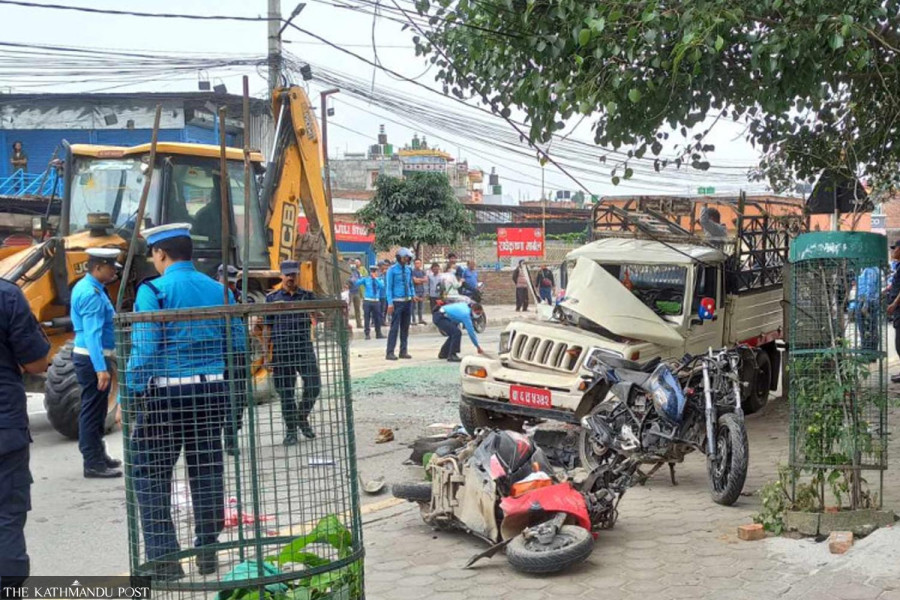Kathmandu
Road pileup highlights traffic perils in the Valley
Rate of road accidents has remained unchanged in traffic-clogged Kathmandu over the past few years, even as traffic police claim they have tightened surveillance for rule violations.
Anup Ojha
Two people died and 12 were injured when a passenger bus collided with a van and two two-wheelers at Chhapro, near Pepsicola, in Kathmandu on Sunday morning. The speeding bus with the registration number Ba 3 Kha 4848 veered off its lane, flipped over and rammed into an oncoming pickup truck, a scooter and a motorcycle, police said.
According to the District Police Range, Kathmandu, the deceased are motorcycle rider Raj Bhattarai, 21, originally from Sarlahi, and a scooter pillion rider, Usha Thapa, 25, from Sinamangal. The injured are undergoing treatment at a Pepsicola-based hospital, Sinamangal-based Kathmandu Medical College (KMC), and the Armed Police Force Hospital.
Police have detained the bus driver, Janak Raut, 24, and kept him at the Metropolitan Police Circle New Baneshwar for investigation.
“This horrible accident was caused due to high-speed driving,” said Rajendra Prasad Bhatta, senior superintendent of Police and spokesperson at Kathmandu Valley Traffic Police.
In traffic-clogged Kathmandu, the rate of road accidents has remained unchanged over the past few years, even as traffic police claim they have tightened their surveillance. According to Valley traffic police data, as many as 378 people have been killed in road accidents in the Valley in the past two years. In the fiscal year 2022-2023, Kathmandu Valley saw a total of 10,675 road accidents, where 187 people were killed, while in the preceding year, 191 people died in 10,733 accidents. Police have booked 80,715 persons for speeding in the past three years.
Speeding, followed by drink-driving and other traffic rules violations such as flouting of lane discipline, jaywalking and traffic light violations, are the major causes of road accidents in the Valley, police say.
“Over 30 percent of road accidents occur due to high speed,” Bhatta said. “We have taken stringent measures to control it.”
Traffic police have launched various programmes to minimise road accidents caused by high speed. The Valley police recently introduced Automatic Number Plate Recognition (ANPR) cameras in three places in the Valley. ANPR is a technology that uses optical character recognition software and high-resolution cameras to capture images of vehicles’ number plates and can also recognise the driver’s face. However, there has been no significant reduction in accidents on the Valley’s roads.
Ashish Gajurel, a transport and traffic engineer, said as long as drivers, two-wheeler riders and pedestrians continue to flout traffic rules, it will be hard to bring down the number of accidents in the Valley.
“We can reduce the accident rate only if drivers refrain from speeding and follow lane rules, pedestrians use the footpath and use zebra crossings, and authorities properly monitor traffic rules violations,” Gajurel said.
He added that while road accidents in hilly areas are mostly caused due to treacherous terrains, and that is something unavoidable, in places like Kathmandu, they can be brought down through effective monitoring of speeding and traffic rule violations.
“The traffic police and all the stakeholders should introduce more awareness programmes,” Gajurel said. “Traffic rules should be taught in schools too.”




 22.64°C Kathmandu
22.64°C Kathmandu.jpg)












